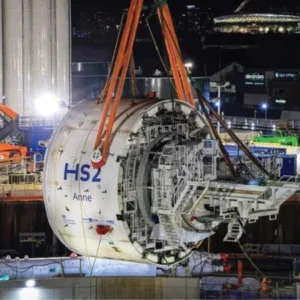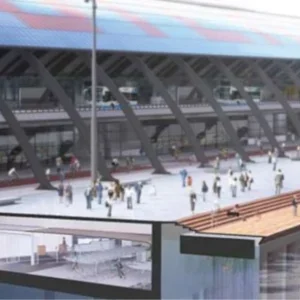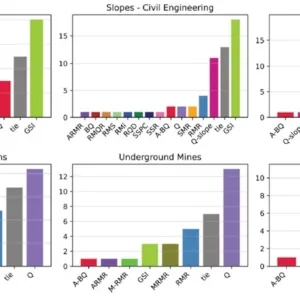Limerick City is situated on the river Shannon approximately 60 miles from the open sea. King John’s Castle was constructed in 1211 to control Thomondgate Bridge, which was the lowest crossing point on the Shannon at that time. In the 18th Century, hostilities between the English and Irish died down allowing Limerick City to expand beyond the small garrison town of Kings Island.
This boom period saw the construction of new quays, wharfs and warehouses that were built along the banks of the Shannon on the low lying marshes. On the higher ground, the overlying glacial tills were removed to allow large Georgian Houses to be built directly on the bedrock with large basements. Drainage channels were constructed in the centres of the roads with walls on each side and an arched top to form the sewer. These sewers were then covered with the excavated fill to form the new roads. The sewers were built some 60 years before piped water arrived in the city and had large walk-in connections from the basements. Chamber pots were emptied and the groundwater or rain from the surface drains would take it directly to the river.
By the late 20th Century, the city was in desperate need of a modern sewerage system in order to deal with 22,000m3 of untreated sewage discharging directly to the river from 50 outfalls. The construction of an extensive sewerage system was required to comply with the EU Urban Wastewater Directive and the Shannon Estuary Water Quality Management Plan.
The proposed sewerage system includes 48km of sewers with nearly 7.5km in pipejack and 2.5km in 2.8m diameter tunnel. The project also included a treatment works and five pumping stations.
Ground conditions
The castle and most of the older buildings in Limerick are made from the local limestone bedrock with a UCS of between 160 and 250N/mm2, classifying it as Strong to Very Strong. When fresh it is generally massive with little or no joints. Where it is exposed it weathers to form typical karst features.
Overlying the bedrock are glacial till and fluvial deposits of water bearing sands and gravels with cobbles and large boulders. Soft alluvial clayey silts are also present. In addition, low lying marshy areas had been reclaimed with loose fill material.
In the Corcanree area of the city, where large areas of land had been recovered from the tidal marshes, there has been an ongoing settlement problem. Because of the very soft underlying silts nearly all of the buildings were constructed on piled foundations. The possibility of settlement during tunnelling in this ground was foreseen as a major risk. Contractual clauses set strict controls on the amount that the water table could be lowered. A substantial groundwater and settlement monitoring regime was also included in the main tunnelling contract.
Underground structures
Made ground, particularly the older variety close to the city centre, also provided a number of surprises. During the construction of one of the first shafts, on the Clair side of the river, a number of vaulted arch road foundations were encountered.
Radar surveys identified a number of other arched vaults and chambers under the same road. These vaults were away from the shaft location but they needed to be filled and stabilised as the tunnel would be constructed immediately below them.
The solution was fairly simple. Remove the loose fill, which in this case was about 80m3 from a chamber thought to have been used for sewage storage during high-tide periods. The chamber was then refilled with foamed concrete, which was very fluid, ensuring all cavities were filled, and had a strength of about 4N so it could be easily excavated.
Existing sewers
The collapse of an old sewer in the City raised concerns over the condition of the other old culverts, particularly those that passed over the tunnel line. An assessment was carried out to determine if they would withstand the predicted 20mm settlement and the additional hydrostatic loads imposed when they were sealed off from the river. This inspection was not simple as the sewers were tidal, there location was vague and many of the manholes had been covered over.
Firstly the sewers had to be cleaned before they could be strengthened. The sewers were constructed from blocks of the limestone bedrock. The blocks were sound but most of the mortar had been washed away as had the fines behind the stone walls. One of the lining systems used to strengthen the sewers was the Panel Loc System recently developed in Australia. The system comprises a 200mm wide ribbed UPVC sheet that comes in 50m long rolls.
The rolls are unwound into the culvert to form coils around the inside of the sewer. Each coil is then joined to the previous coil by a small jointing strip. The annulus between the liner and the culvert was then filled with grout. The grout fills the cavities between and behind the limestone blocks binding them together forming a very strong, smooth, composite lining. The main advantage of this system is that everything can be done through the existing manholes. The work was carried out at night within a coned off area. In the morning the manhole covers were replaced and the cones removed ready for the morning rush hour.
Shaft construction
Shaft construction was carried out by various methods but the most popular was the caisson. Both standard and smoothbore segmental linings were successfully used during shaft sinking. Though the water flows were generally modest, conditions were wet and muddy. Breaking boulders out from under the cutting edge was often a continuous operation.
Once down to the rock, breakers and drill & blast methods were used for excavation and the rings completed by underpinning. The limestone shattered very well, but the soft overlying silts are good transmitters of vibration. The maximum instantaneous charge had to be carefully controlled, even during the river crossing. The MIS was kept below 2kg to meet the 20mm/s/s particle acceleration limit. At least two automatic vibrographs were used to record each blasts
If wet at the formation level, a layer of clean stone with a perforated pipe leading to a steel sump was often installed. Visquene and blinding would be placed on top of the stone to form a drainage layer and a base on which to construct the reinforced concrete base slab. A double run of hydrophilic strip around the bottom ring ensured a water-tight seal to the shaft. Once the slab reached its 28 day strength the drainage layer was pumped full of grout.
The internals of the shaft usually consisted of DI drop pipes and mass concrete. Where standard shaft segments were used a secondary lining was required. To save time one of the contractors used manhole rings to form a lost internal shutter. Although expensive in material costs, this approach coupled with the use of bespoke GRP channel formwork cut the shaft finishing programme by more than 50%.
On larger shafts with sewer connections over 900mm vortex drop pipes were installed. The vortexes spin the sewage and throw it to the sides of the drop pipe, reducing impact loads.
Tunnels
To minimise the running costs of the pumping station it was necessary to minimise the height that the sewage needs to be pumped. This requirement dictated that the sewers were as shallow as possible. The limiting feature of this requirement was where the Northern Interceptor sewer crosses the River Shannon. Only half a metre of cover below the river bed was allowed in the design. This alignment puts the majority of the tunnelling along the interface between the bedrock and the soft alluvial silts. This was also about the low tide mark. These were never going to be easy tunnelling conditions.
A number of short adits were required to connect the shafts to the main tunnels. Some were in rock and were constructed by drill and blast with no support necessary. Others were in the very soft silt and were driven using soft ground TBMs such as the Iseki Unclemole.
One of the most popular TBMs on the scheme was the 1.8m diameter Herrenknecht AVN Slurry TBM fitted with a full set of disc cutters for the hard ground.
On three of the microtunnels it was necessary to incorporate 500m radius curves into the alignment. These were needed for a variety of reasons. One was to overcome a survey error, another to avoid going beneath a building or constructing another shaft and the last to avoid a drill steel that had become jammed on the tunnel line during a ground treatment operation. Even in this poor ground the TBMs and the pipestrings coped exceedingly well with the 500m radius curves. A recovery shaft was needed on the Northern Interceptor when the TBM ran into a large piece of steel in the foundations of an old demolished whiskey distillery. Research at the local library confirmed the position of the main buildings and that the TBM was half way along its length. To avoid similar problems Bactec were commissioned to carry out a magnetic survey through the remainder of the building’s basement. This survey is usually used to find UXBs but it also managed to identify three other metal targets. These were excavated and pieces of scrap iron removed before the TBM came through.
The project contained four river crossings, all constructed by a different method.
The most upstream crossing was at Athlunkard Bridge where the crossing was carried out by open-cut within a bund. A submerged tube method was used to cross the Abbey River using a steel pipe encased in a reinforced concrete sleeve.
The lowest 500m long crossing was carried out as a 2m diameter pipe jack using the Herrenknecht Slurry TBM. The 1.8m diameter 200m long crossing was the most challenging as there was only 500mm of cover to the riverbed and there were concerns that any obstruction in the river could cause flooding. The solution the contractor came up with was a jacked pipe within an open-cut submerged trench.
Dock Road Tunnel construction
The Dock Road Tunnel forms the main sewer link from the city centre to the pumping station and treatment works at Corcanree on the west of the city. Constructed by Murphy Construction under a US$26.6M contract the works included 2.5km of 2.82m diameter tunnel, 11 major shafts and connections and 1000m of ancillary sewers.
The tunnel horizon passed in and out of the limestone bedrock (figure 1). Murphy selected a new Lovat RMP 131se Series TBM for the mixed ground conditions anticipated from the geological section. The face was equipped with a combination of both 14” disc cutters and picks, weighed 90 tonnes and operated in closed mode with a total installed power of 1200hp. The tunnel lining comprised 1m wide, 180mm thick ‘one pass’ segments with 65% of the segments reinforced with fibres and 35% with steel cage reinforcement.
The tunnel was driven from the 9m diameter working shaft, ISL2 (figure 2). Concerns over dewatering and subsequent ground movements led to ground treatment being carried out at the shaft. This allowed the shaft to be pumped out to facilitate excavation of the numerous boulders encountered during the construction using the jacked caisson method.
The first drive, from ISL2 to ISL1 was almost entirely in gravels/cobbles and although progress was slow the drive was completed successfully without damage to the cutter tools. The second drive, from ISL2 to ISL5 was in variable strata, starting in the gravels but with full face intrusions of limestone. The original face configuration of mixed rippers and disc cutters could not cope and had to be changed to a full face of 26 disc cutters
Access to the face was achieved through an inspection pit sunk on to the shield. The cutters were found to be badly damaged and had to be replaced. The cutters had to be replaced again before reaching ISL5 and another inspection pit was required.
The final section from ISL5 to the temporary pumping station, was 1360m long and was almost completely in the limestone, so the TBM was removed for a complete overhaul. A further 17 interventions were required to replace cutters in addition to the planned access at the four shafts for manholes left on the drive. Tunnelling outputs included a best shift of 10 rings in the full face of limestone and 16 rings in the mixed face conditions. The adit connections to the main tunnel were all relatively short and were constructed by drill and blast techniques and hand excavation. A longer connection in soft ground from ISL13 to ISL2 was completed using a 1500 Iseki machine that was received on a special staging part way up the completed shaft.
The ground conditions had presented major challenges to be overcome during construction and a variety of tunnelling techniques were required to achieve the successful completion of the project.
Questions & Answers
Neville Harrison, of Mott MacDonald, noted that the EPBM had struggled in the prevailing ground conditions and although it could deal with soft ground in closed, wondered if a slurry machine may have been a better option?
Peter Jacques replied that polymers and foams were required to condition the material in the rock to allow the machine to operate in closed mode. With hindsight, a slurry machine may have been a better choice.
Chris Hughes, of Morgan Est, asked why the horizon had not been lowered so that mixed face tunnelling could have been avoided, whilst recognising that greater pumping would require a trade off on costs.
Ken MacIntyre replied that this was considered at the design stage and had been discussed with contractors. The decision was taken in order to minimise costs to the client.
Bill Grose, of Arup, asked if a whole life cost assessment had been carried out and Ken MacIntyre confirmed that this had been carried out based on construction cost estimates at the time.
John Murphy, of Tubelines, queried how the work was paid for. Ken MacIntyre said it was re-measured in the normal way with some compensation for inflation. The final account had not been completed as there were still claims for additional costs to be settled.
David Brook, independent consultant, noted that blasting limits of 20mm/sec were specified and wondered whether there were many complaints. He also asked whether the excavated material had been re-used?
Russell Naylor replied that there were very few complaints about blasting but more about the noise from the breakers. Excavated material was used on building sites and some used for reclamation of derelict land for a park development. Ken MacIntyre confirmed that this re-use had saved around €25/m3 on disposal of 250,000m3 of material.
Colin Eddie, of Morgan Est, asked how the rate of spoil removal had been measured in areas where settlement was an issue.
Russell Naylor stated that a rough calculation of 6.5 skips per ring had been used to monitor excavated material.
Raporteur: Geoff Bateman
Shaft sinking employed a variety of methods including drill and blast Shaft sinking employed a variety of methods TBM breakthrough showing the fracturing of the local limestone predominant in the tunnel face TBM breakthrough achieved Figures 1 (top) & 2 – Longitudinal section and plan of Dock Road Tunnel Figures 1 & 2 – Longitudinal section and plan of Dock Road Tunnel Pipe jacking underway from the caisson constructed shaft Pipe jacking underway from the caisson constructed shaft Damage to the cutters on the Dock Road Tunnel proved a problem Damage to the cutters Alternate view of damage to the cutters A finished section of the Limerick Main Drainage Scheme Finished section






